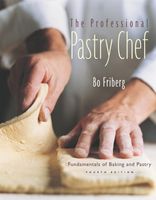Advertisement
Baking powder
By Bo Friberg
Published 1989
Baking powder is a leavener composed of one part sodium bicarbonate and two parts baking acid (generally cream of tartar, although phosphates are used in the case of single-acting baking powder), plus a small amount of starch to keep the product from caking. When baking powder comes into contact with liquid and heat, it releases carbon dioxide gas, which, in the case of a cake batter, for example, causes the batter to expand and rise as it fills with the gas bubbles. Single-acting baking powders react and release gas only when they come in contact with a liquid, which makes them impractical for use in some recipes. Double-acting baking powders, the type more commonly used and the type used in the recipes in The Professional Pastry Chef, react to both liquid and heat. Double-acting baking powder gives you the advantage of being able to delay baking the product. Provided the correct amount is used, baking powder will not cause an aftertaste and should leave only small, even holes inside the baked dessert rather than large air pockets. Generally speaking, the softer and more fluid the batter is, the more the baking powder will react. At high altitudes, the amount of baking powder called for in a recipe must be decreased. See “High-Altitude Baking” in Appendix C. Store baking powder, tightly covered, in a cool place.


